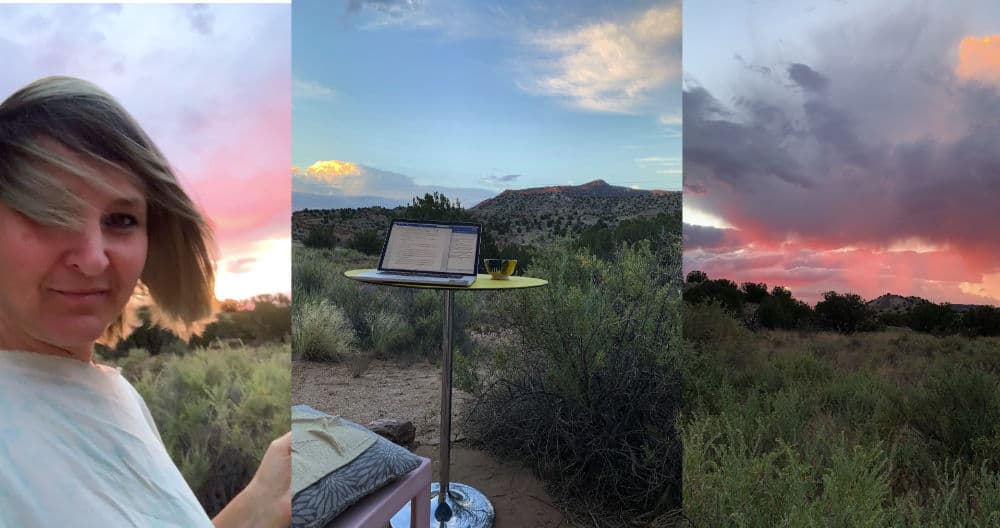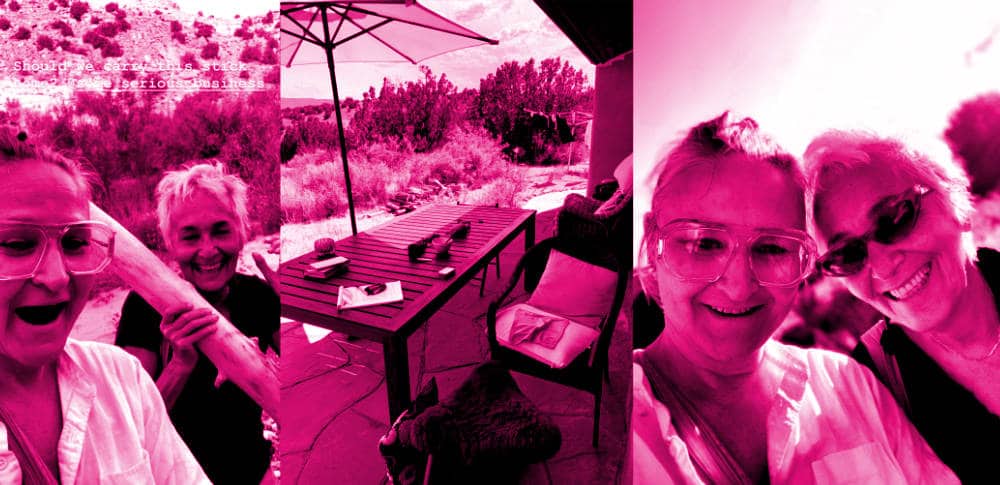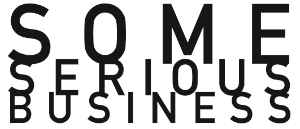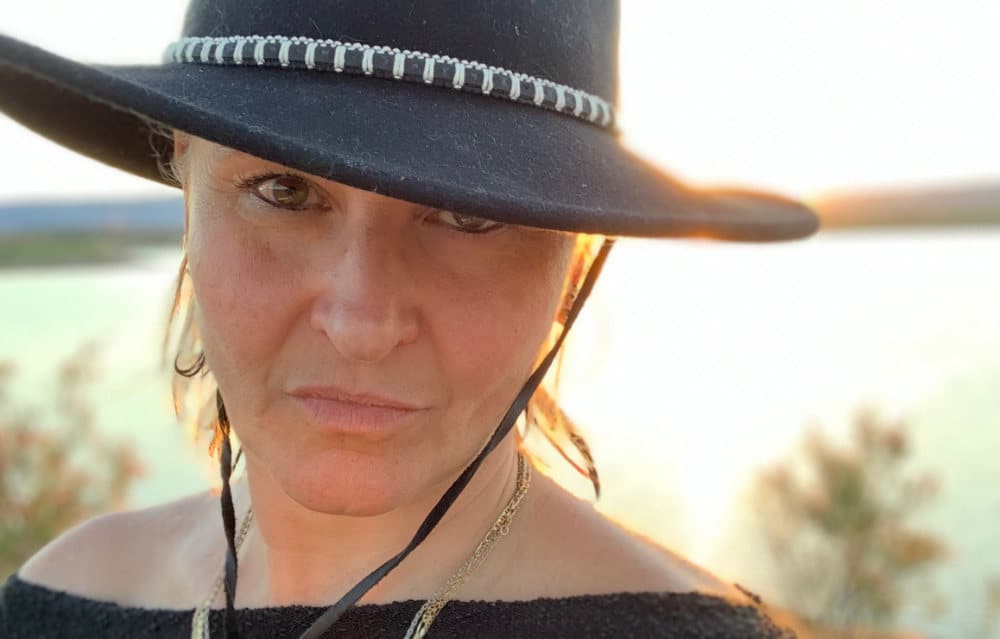Some Serious Business presents #FiftyQuestions to highlight folks who are creating, presenting, questioning and critiquing. Each featured artist picks a handful of questions to answer.
1- What event or factor in your life has been the most pivotal in your decision to become an artist?
A defining feature of my life has been being a human in a female body.
3- What has been the most significant challenge you’ve faced that you overcame to continue your art practice?
Cancers of my ovaries and uterus.
4- Describe your ideal workspace.
RIGHT HERE at SSB Away! I write outside every day. I adore my residency here. I used to dream of having a space where I would work and run a free artist’s residency, but now that I’ve been through motherhood and alcoholism and cancers I really want to be nurtured myself.
My ideal workspace would be about 10,000 square feet! Because I want to start making BIG things. Earth art. Big public sculptures. I want outdoor space to work in. I want a command center, one 1,000 sq room big enough to have a worktable for each of my current projects.
One table for writing, one table for conceptual work and performance, one table for visual art, one table for the film I’m working on, one for archiving and paperwork, a table for painting, a table for my sewing machine.
I want an assistant, especially for the paperwork. There would be ample storage, and a gallery for studio visits. Slop sinks and big windows, solar energy and a kitchenette.
I would love to have an outdoor area for nude sunbathing in warmer months.
I would love to have a compound with other artists, where we meet at the bath house.
I would love to be able to swim and play with my kids and make art and have sex and see friends and nap and take long walks in nature and dance and see theatre and art every day.

15- What surprises you most about what you are doing right now in your practice? If the nine year old you could see you right now, what do you think s/he would think?
I certainly never thought that I would be working with the color pink! I was the type who started wearing black in middle school. I don’t know about my 9 year old self…that self was before the understanding of society’s concepts of gender became super obvious. I don’t think my 9 year old self could have imagined my Pussy Bow, for instance. I believe in humor in revolution. I think the Pussy Bow is funny- it’s a literal interpretation of a fashion item that already exists.
It’s also a way of turning the inside out in order to make it visible.
And with the continuation of Interiors, I’m looking for a third way, an open feminism, an interiority that is intersectional, that includes all genders and trans as well as cis bodies, includes the penetrated male, that includes masculinity as well as femininity, that includes non binary folx. I’m not sure if we can abolish the gender binary, but we can, as feminist theorist Ann Snitow says, “live on the edge of it.” We Are All Pink Inside is a material investigation of intersectional feminism.
16- What do you worry you will never be able to express?
I worry my children will never know how much I love them. I didn’t understand how much my parents loved me until I became a mother. That does NOT mean that motherhood is a magical cure all. People should not be pressured or forced into having children. Childless is a good choice.
18- Can you recall your first memory of bliss in self-expression?
I remember being onstage in 8th grade and walking towards the wings for my exit and not wanting to leave. I remember doing a monologue in Erotica Project at HERE theatre and feeling like I was a vessel, that the words and emotions just flowed through me. When I am in the flow I don’t notice it, but occasionally someone will point it out. I remember I was writing our mother’s obituary in my parents’ dining room and my sister Cindy came in and said, “You smile when you write.” And I had been looking for a word and I was kind of acting out the feeling to find the word and it was just blissful.
28- When does Joy tend to visit you?
Joy visits me when I am paying attention.
30- If you have one goal for change in your artistic field, what would it be?
I want all arts fields to become more diverse by age, gender, sex, color. All of it. When I grew up in the ’70s, I thought race was real, that people with different skin colors were different on the inside. It wasn’t until I was in my 30s that I really understood that I deeply understood race was a false construct.
That’s some deeply ingrained shit. Look at what the fuck is happening right now- Facist rallies and cries of “Send her back?”
I try to educate myself about blackness and whiteness, and I try to understand my white privilege and work to support other artists. What is easing someone else’s pain worth? Discomfort on my part? Certainly. I hate censorship, and I hate hate speech.I want to live in a world without rape.
What do I want? I want more women of color in charge of institutions, and as critics and publishers. POC in leadership positions. I want the whole system to change. Do we need Capitalism? Women were property before Capitalism.
I want everyone to read Aruna D’Souza’s Whitewalling: Art, Race and Protest in Three Acts. I want to abolish the Catholic Church. I everyone to have sexual pleasure.
What do I want for everyone? I want Universal Basic Income, Health Care for All, Universal Child Care. I want every person to have time for contemplation every day, and access to nature and healthy food and clean water and air. I want therapy with plant medicine to rewire some of my negative thinking.
32- How has your years in artmaking affected or influenced your sense of self?
In years where I wasn’t making much work or when I was raising my kids as a stay at home mom I got depressed. I need to communicate and make art. I truly enjoy sharing my work; all of my work is performative in some way, I love having an audience, being in a room with people in an intimate setting! I find it very gratifying.
Looking back, the work I’ve made has often been made in a response to my limitations. I was an actor when I was young, childless, and had a lot of freedom. After I had my first child, I went and got an MFA in Creative Nonfiction at The New School. Later, I made some solo shows combining those skills, when I had a second child I went full on into performance art.
My sense of self is dependent on being able to make the work I want to make. To have that freedom.
33- What do you suspect is your most powerful artistic blessing? Or blessing in general?
My most powerful artistic blessings are love and honesty.
34- Have you ever had a physical illness, event, or impediment that has changed how you make or approach artmaking?
In 2016 I was diagnosed with uterine and ovarian cancers. I very quickly understood that my social media was turning into my art. I couldn’t do anything else. My Instagram became my work. It started with documenting the process. I’d been documenting my healthcare when I started to get mammograms a few years before with a breast cancer scare and tagging it things like #womenshealthcareasperformanceart and #feministperformanceart so I was posting mammograms about every 6 months and then when I was diagnosed with ovarian and uterine cancers it just seemed normal to me to document it.
36- Who or what do you feel is most invisible to others in your practice?
Family. My mother is in all of my work. I used to think everything I did was for her. I think about her life and her experiences of sexism, our culture as whole is inherently sexist- and racist and classist.
My mother (who is deceased) was born in the ‘30s, I was the youngest of 8 children, she had me when she was 42 or 43, which in ‘71 was very late but is now the age when many women are having their first children in the US. She was Catholic, which meant NO birth control. Once I asked my father (also deceased, he was born in the early ‘20s and was in the US Army in WWII) what they did, and he said, “She took her temperature!”
Family stories have it that she also had at least two miscarriages, and two abortions after I was born. I was born in ’71. Let’s do the math. Roe V. Wade was in ’73, but New York State allowed abortions before that, but I doubt they were easy to get in Buffalo. She already had EIGHT children. She had graduated from RIT with a degree in textile design, and then became a stewardess- this is back in the day when air travel was glamorous and you had to have certain measurements.
She had to wear a little navy blue wool suit, had to be certain weight and height, and when she married my father she didn’t wear her wedding ring (because stewardess were not allowed to be married, so she was a bit of a rebel- I like to think that’s where I get it from.) She was forced to resign and stop working when she was pregnant with her first child and showing.
If that isn’t sexist, I don’t know what is.
And believe me I am glad I was born, and I am happy to be alive, but I wonder if my mother’s life would have been better off if she had had less children. In fact, I’m pretty certain of it.
I had an abortion in college. It was my choice and it was the right choice. I wouldn’t have the two amazing small humans I am lucky to share my life with now if I hadn’t made that decision in my early 20s.
Also, the fact that I spent most of the past fifteen years schlepping kids and strollers around like a Sherpa, and was the primary caretaker for the children I have with McKenzie Wark, I feel like that is invisible. But also my relationship to the invisible work of motherhood, which is related to my own mother. Whenever I see the phrase “forced motherhood” I think of my mother.
38- How important is it to you that others connect and understand and appreciate your work?
(My real answer to this is below in questions 39 and 40) I love being in conversation with other artists, being in the room with people I like and admire and want more of their work and talent in my life. I am so fucking hashtag blessed! Look at this, this is a partial list of artists I have shown with or performed with recently! I feel like the luckiest person on the planet!
(When I had cancer I really felt like the luckiest person on the planet, now as I’m in remission my neurosis are coming back.) I mean I can’t mention everyone, but I get to straddle art and literature and academia and theatre and performance and film. I curate Experiments and Disorders with Tom Cole at Dixon Place and I organized and chaired two Symposia on Rape Culture and Art last year (at CAA/The Feminist Art Project, and at The New School) so I get to spend time with some amazingly talented humans that everyone should know about:
Visual artists: Ayana Evans, Jodie Lyn-Kee-Chow, Xandra Ibarra, Jennifer Tamayo, Camille Lee, Chaya Babu, Katherine Toukhy, Andrea Arrubla, Debora Castillo, Scherezade Garcia, Mona Saeed Kamal, Baseera Khan, Sarah Maple, Hồng-Ân Trương + Hương Ngô, Nicole Goodwin, Rindon Johnson, January Hunt, OlaRonke Akinmowo for Free Black Women’s Library, Becca Albee, Amelia Bande, Lukaza Branfman-Verissimo, Carolyn Lazard, Candice Lin & Patrick Staff, Julie Tolentino, Quay Quinn Wolf, Sarah Zapata, Karen Finley, Andrea Long Chu, The Museum of Motherhood, Sophia Wallace, The Black Women’s Blueprint, fayemi shakur, Karen Malpede, Daniel Fish, Julie Kramer, Aya Ogawa, Project for Empty Space, Dixon Place, Elizabeth Foundation for the Arts, Rebecca Jampol, Jasmine Wahi, Stamatina Gregory, IV Castellanos, Katya Grokovsky, Maria Hupfeild. And of course Susan Martin from SSB!
39- What is your relationship to criticism?
My relationship to criticism is that …I like it. When someone takes the time to think deeply about my work, I love it. But, if you mean criticism as in negative comments about my work, I can still remember word for word every negative thing ever written about me.
When I perform, I can’t read reviews. Even if it’s good. What if the reviewer wrote that liked something about the way I delivered a certain line? Then, every time I had to say that line, all I would be thinking about was that I had to do it that way. I’ve even told directors, don’t tell me if I’m doing something specific that you like, because that is what will stick in my head. If I stop doing it, let me know!
40- What is your relationship to praise?
I love praise. I love feeling supported, and it feels good to have made something that other people like. I don’t need it, and I will make work regardless, but I can’t deny that I want to be loved. Of course, I can’t remember my positive reviews! But I will look this up: There was something in Bomb Magazine about my performance in Laura Parnes’ film Tour Without End that said a scene I was in was “the most provocative menage a trois known to cinema.” That delighted me no end.
42- How would you describe the prevailing norms in your field – are you impacted by them? How or how not?
I try not care about norms. Fuck it, who says I can or can’t do something?
I’m making my first film. It’s an experimental autobiographical documentary called Cancer A Love Story. I never done anything like it, so it’s huge and free! Of course, I am working with an expert documentary editor and an experienced documentary producer to make up for what I don’t know, but that means I get to bring my art to a new medium.
43- What is your relationship to your audience, real or imaginary?
I was thinking about loyalty to humans and loyalty to the earth yesterday. Loyalty is very doglike. I have a responsibility to work from love and to tell my truth. Sometimes I will imagine a specific audience.
My work really shifted after my daughter was born ten years ago. I was walking down Bedford in Brooklyn and a young woman stopped me on the street to compliment me on a performance she had seen me do.
I realized that the old white men who were in power were never going to support me, the ones who turned down my book proposal about post maternal sexuality for example, the ones who were in power. I was barking up the wrong tree. I realized my audience was mostly younger women. This was like 8 years ago when I was making a lot of work with menstrual blood. I love the support I get from younger women.
46- Which would you prefer: to be a rogue artistic outsider or to fit within a community of similarly-minded creators?
Both. A rogue who is accepted for who I am.
christenclifford.info
Twitter and IG: @cd_clifford


